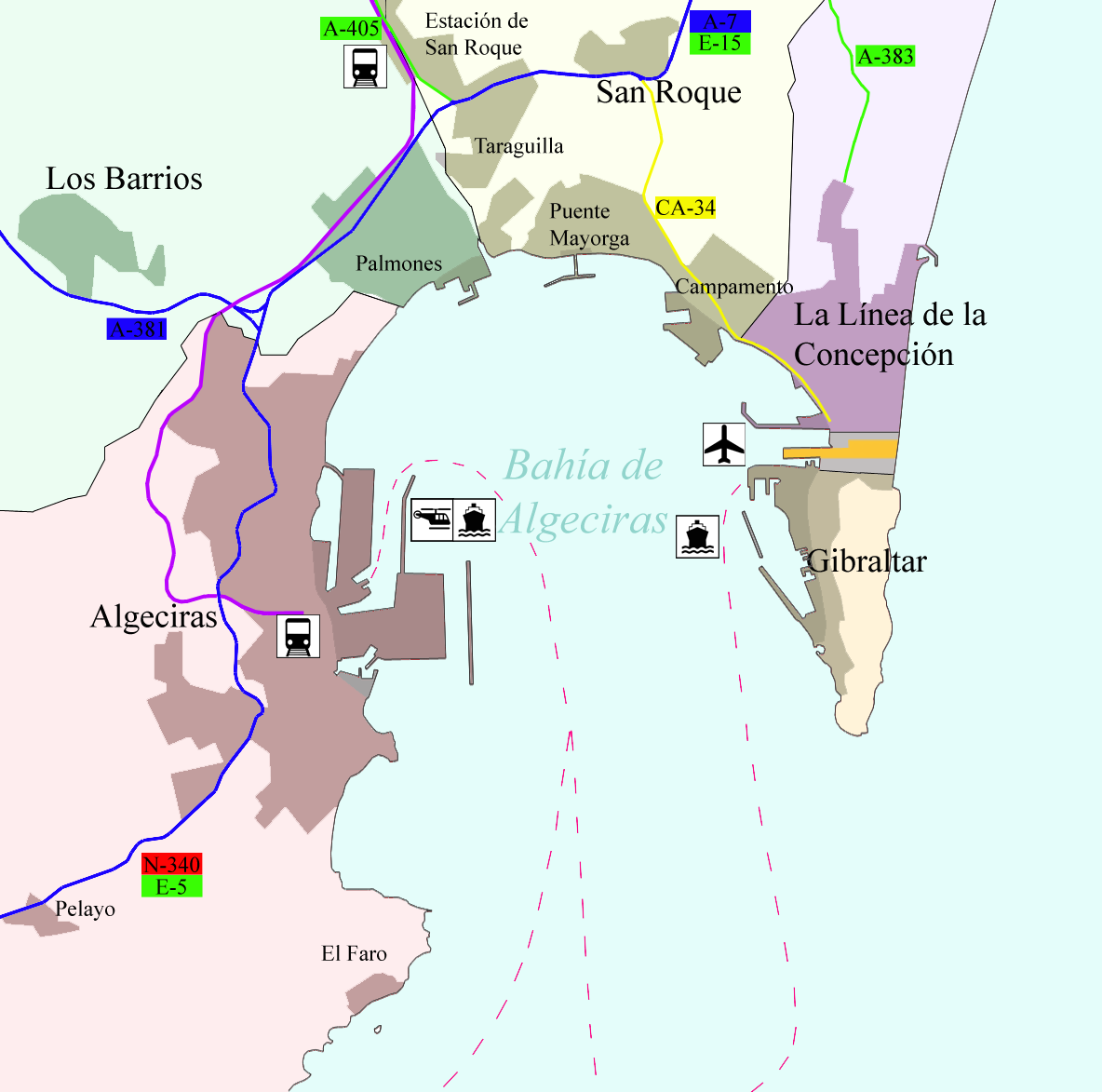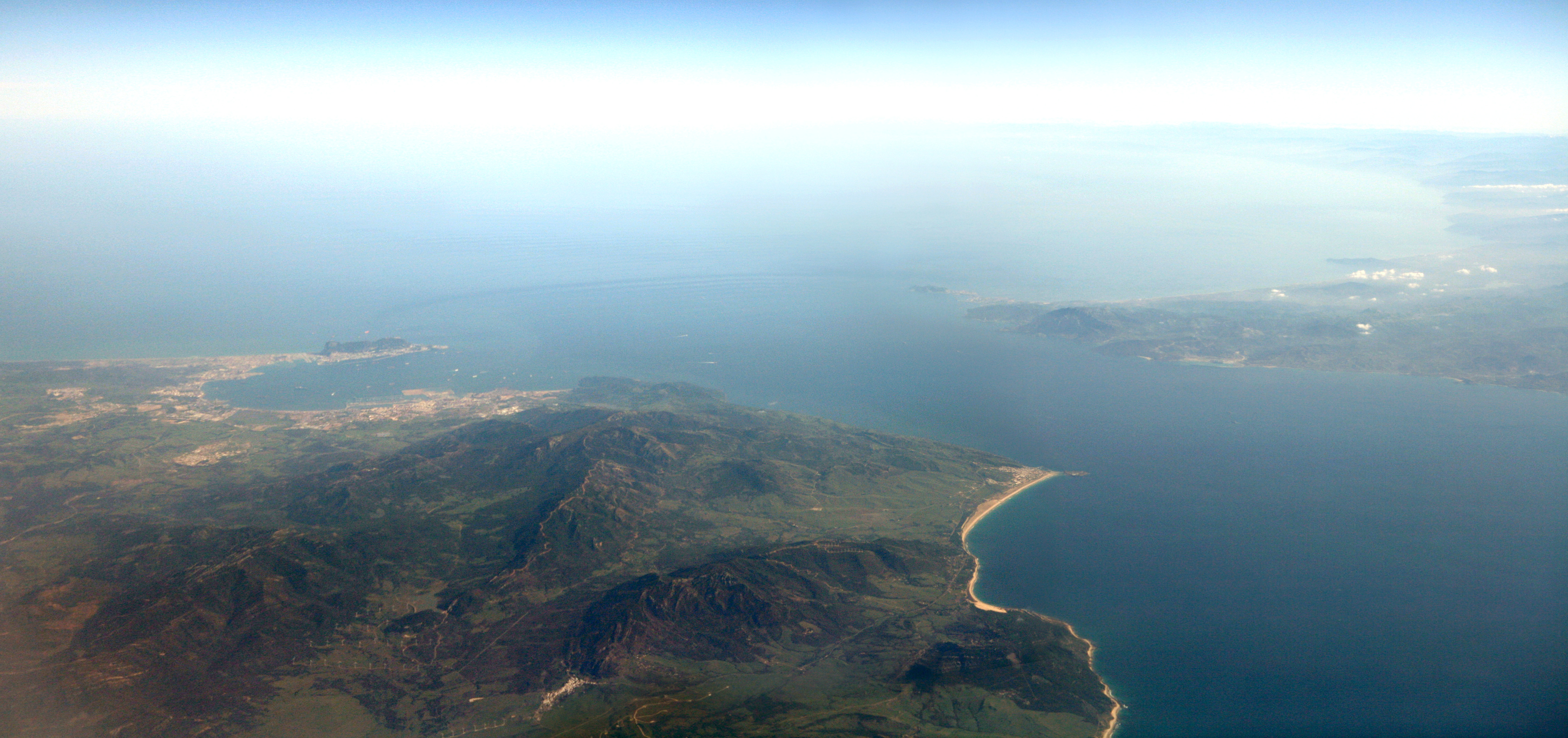|
Playa De Getares
Playa de Getares is a beach in the municipality of Algeciras, southeastern Spain. It overlooks the Bay of Gibraltar about south of the city of Algeciras, between Punta San García and Punta Carnero, where the cliffs begin on the Strait of Gibraltar The Strait of Gibraltar ( ar, مضيق جبل طارق, Maḍīq Jabal Ṭāriq; es, Estrecho de Gibraltar, Archaic: Pillars of Hercules), also known as the Straits of Gibraltar, is a narrow strait that connects the Atlantic Ocean to the Medi .... It is approximately in length and wide on average. The name comes from a Roman fish salting factory which was located in the old Roman town in the vicinity of Caetaria, and was called Cetares, and then Xetares during the Middle Ages, named in the chronicles of Alfonso XI. The whole beach is surrounded by terraced housing developments and has a promenade with bars and restaurants. References External linksVideo {{Andalusia-geo-stub Algeciras Beaches of Andalusia Geograp ... [...More Info...] [...Related Items...] OR: [Wikipedia] [Google] [Baidu] |
Algeciras
Algeciras ( , ) is a municipality of Spain belonging to the province of Cádiz, Andalusia. Located in the southern end of the Iberian Peninsula, near the Strait of Gibraltar, it is the largest city on the Bay of Gibraltar ( es, Bahía de Algeciras, link=no). The Port of Algeciras is one of the largest ports in Europe and the world in three categories: container, cargo and transshipment. The urban area straddles the small Río de la Miel, which is the southernmost river of continental Europe. As of 1 January 2020, the municipality had a registered population of 123,078, second in its province after Jerez de la Frontera and greater than Cádiz city population. It forms part of the ''comarca'' of Campo de Gibraltar. The surrounding metro area also includes the municipalities of Los Barrios, La Línea de la Concepción, Castellar de la Frontera, Jimena de la Frontera, San Roque and Tarifa, with a population of 263,739. Name Algeciras' site was also that of Roman cities called ... [...More Info...] [...Related Items...] OR: [Wikipedia] [Google] [Baidu] |
Bay Of Gibraltar
The Bay of Gibraltar ( es, Bahía de Algeciras), is a bay at the southern end of the Iberian Peninsula. It is around long by wide, covering an area of some , with a depth of up to in the centre of the bay. It opens to the south into the Strait of Gibraltar and the Mediterranean Sea. The shoreline is densely settled. From west to east, the shore is divided between the Spanish municipalities of Algeciras, Los Barrios, San Roque, La Línea de la Concepción and the British Overseas Territory of Gibraltar. The larger part of the shoreline is Spanish territory, with part of the eastern half of the bay belonging to Gibraltar. The east and west entrances to the bay are marked respectively by the Europa Point Lighthouse at Europa Point, Gibraltar and the Punta Carnero Lighthouse in Punta Carnero to the west of Algeciras. History The area around the Bay of Gibraltar has been inhabited for millennia and the bay itself has been used by merchant shipping for at least 3,000 years. Th ... [...More Info...] [...Related Items...] OR: [Wikipedia] [Google] [Baidu] |
Punta San García
Punta is an Afro-indigenous dance and cultural music originating in the Caribbean Island of Saint Vincent And The Grenadines by the Garifuna people before being exiled from the island. Which is also known as Yurumei. It has African and Arawak elements which are also the characteristics of the Garifuna language. Punta is the best-known traditional dance belonging to the Garifuna community. It is also known as banguity or bunda, before the first arrival of the Garifuna people in Punta Gorda, Roatan, Honduras on April 12, 1797. The diaspora of Garifuna people, commonly called the "Garifuna Nation", dates back to the amalgamation of West African slaves and the Arawak and Carib Amerindians. Punta is used to reaffirm and express the struggle felt by the indigenous population's common heritage through cultural art forms, such as dance and music, and to highlight their strong sense of endurance as well as reconnecting back to the ancestors of the Garifuna people. Besides Honduras, p ... [...More Info...] [...Related Items...] OR: [Wikipedia] [Google] [Baidu] |
Punta Carnero, Spain
Punta Carnero is a headland on the coast of Spain, near the city of Algeciras, where the eastern end of Gallows Hill descends 200 metres to meet the Mediterranean Sea. Its most prominent feature is Punta Carnero lighthouse, which marks the entrance to the Bay of Gibraltar and the Strait of Gibraltar. Goat Island lies near the lighthouse, and the Bay of Getares begins here. History In August 1415, a Portuguese fleet captained by King John I of Portugal held a Council of war, before carrying out the conquest of Ceuta, while anchored off Punta Carnero.Peter Russell, ''Prince Henry 'the Navigator' A life'', Ed. Yale Nota Bene, 2001, p47-p48 See also * Europa Point Europa Point (Spanish language, Spanish and Llanito: Punta de Europa or Punta Europa), is the southernmost point of Gibraltar (the southernmost point of the Iberian Peninsula being Punta de Tarifa 25 km southwest of Gibraltar). At the end of ... References * Madoz, Pascual (1845)''Diccionario geográfico-estad ... [...More Info...] [...Related Items...] OR: [Wikipedia] [Google] [Baidu] |
Strait Of Gibraltar
The Strait of Gibraltar ( ar, مضيق جبل طارق, Maḍīq Jabal Ṭāriq; es, Estrecho de Gibraltar, Archaic: Pillars of Hercules), also known as the Straits of Gibraltar, is a narrow strait that connects the Atlantic Ocean to the Mediterranean Sea and separates the Iberian Peninsula in Europe from Morocco in Africa. The two continents are separated by of ocean at the Strait's narrowest point between Point Marroquí in Spain and Point Cires in Morocco. Ferries cross between the two continents every day in as little as 35 minutes. The Strait's depth ranges between which possibly interacted with the lower mean sea level of the last major glaciation 20,000 years ago when the level of the sea is believed to have been lower by . The strait lies in the territorial waters of Morocco, Spain, and the British overseas territory of Gibraltar. Under the United Nations Convention on the Law of the Sea, foreign vessels and aircraft have the freedom of navigation and overflight t ... [...More Info...] [...Related Items...] OR: [Wikipedia] [Google] [Baidu] |
Roman Fish Salting Factory
The Roman fish salting factory ( es, Factoría romana de salazones) was a salting factory established on the seafront of Algeciras, southeastern Spain by the Romans. It belonged to the fishing village of San Nicolás, part of what was called Caetaria. A site of archaeological and historical interest, it was declared a Bien de Interés Cultural A Bien de Interés Cultural is a category of the heritage register in Spain. The term is also used in Venezuela and other Spanish-speaking countries. The term literally means a "good of cultural interest" ("goods" in the economic sense) and inclu ... site on 27 June 2002. References {{coord, 36, 07, 32, N, 5, 26, 38, W, region:ES-M_type:landmark_source:kolossus-eswiki, display=title Buildings and structures in Algeciras Bien de Interés Cultural landmarks in the Province of Cádiz Archaeological sites in Andalusia Ancient Roman buildings and structures in Spain Roman fish processing ... [...More Info...] [...Related Items...] OR: [Wikipedia] [Google] [Baidu] |
Alfonso XI
Alfonso XI (13 August 131126 March 1350), called the Avenger (''el Justiciero''), was King of Castile and León. He was the son of Ferdinand IV of Castile and his wife Constance of Portugal. Upon his father's death in 1312, several disputes ensued over who would hold regency, which were resolved in 1313. Once Alfonso was declared an adult in 1325, he began a reign that would serve to strengthen royal power. His achievements include the victory in the Battle of Río Salado over Granadans and Marinids and the Castilian control over the Strait of Gibraltar. Life Minority Born on 13 August 1311 in Salamanca, he was the son of King Ferdinand IV of Castile and Constance of Portugal. His father died when Alfonso was one year old. His grandmother, María de Molina, his mother Constance, his granduncle Infante John of Castile, son of King Alfonso X of Castile and uncle Infante Peter of Castile, son of King Sancho IV assumed the regency. His mother died first on 18 November 1313, fo ... [...More Info...] [...Related Items...] OR: [Wikipedia] [Google] [Baidu] |
Beaches Of Andalusia
A beach is a landform alongside a body of water which consists of loose particles. The particles composing a beach are typically made from rock, such as sand, gravel, shingle, pebbles, etc., or biological sources, such as mollusc shells or coralline algae. Sediments settle in different densities and structures, depending on the local wave action and weather, creating different textures, colors and gradients or layers of material. Though some beaches form on inland freshwater locations such as lakes and rivers, most beaches are in coastal areas where wave or current action deposits and reworks sediments. Erosion and changing of beach geologies happens through natural processes, like wave action and extreme weather events. Where wind conditions are correct, beaches can be backed by coastal dunes which offer protection and regeneration for the beach. However, these natural forces have become more extreme due to climate change, permanently altering beaches at very rapid ra ... [...More Info...] [...Related Items...] OR: [Wikipedia] [Google] [Baidu] |




